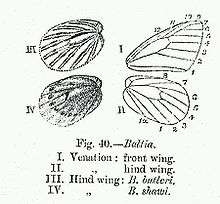Baltia shawi
| Shaw's Dwarf | |
|---|---|
 | |
| Illustration from Stoliczka's Yarkand collection | |
| Scientific classification | |
| Kingdom: | Animalia |
| Phylum: | Arthropoda |
| Class: | Insecta |
| Order: | Lepidoptera |
| Family: | Pieridae |
| Genus: | Baltia |
| Species: | B. shawi |
| Binomial name | |
| Baltia shawi (Bates, 1873) | |
| Synonyms | |
| |
Shaw's Dwarf, Baltia shawi is a small butterfly of the Family Pieridae, that is, the Yellows and Whites, which is found at high altitudes in Central Asia.
Description
- See glossary for terms used
Male on upperside is pale white; base of wings irrorated with black scales. Forewing: costal margin very narrowly yellowish, costal and subcostal veins irrorated with black scales, a discocellular elongate oblique black spot; a narrowly sub-triangular short oblique pre-apical black bar, its apex downwards, and a series of inwardly triangular black spots on the termen, these narrow posteriorly and reach from the apex of wing to vein 1. Hind wing: uniform, the irroration of black scales more extended than on the fore wing.
Underside: forewing white; costa and apex irrorated with black scales, the costa and termen margined with a line of pinkish yellow; the black diseocellular spot, the black preapical bar and terminal series of black spots much as on the upperside, but the last is ill-defined, somewhat diffuse at apex and does not descend below vein 3. Hind wing: white with a dull pinkish tinge all over; the whole surface irroratod with black scales that form a broad elongate patch on posterior half of the wing and an obscure curved macular discal band beyond the cell; disco-cellulars defined with black.

Female differs from the male as follows:— Upperside: somewhat thickly irrorated all over with black scales. Fore wing with the discocellular black spot and terminal series of inwardly-pointed triangular black spots as in the male, but the latter more complete, extends from apex to tornus, the spots are larger and there is no pre-apical bar, out a complete, outwardly dentate, curved discal black band that crosses the wing from costa to dorsum. Hind wing: the irroration of black scales very dense in a broad patch posteriorly, and so arranged as to form a curved macular discal band. Underside similar to that of the male, but on the fore wing there is a complete terminal series of inwardly triangular black spots and a complete, outwardly dentate, curved discal black band; while on the hind wing the irroration of black scales is denser. In both sexes the antennae are white annulated with black, the club black; head whitish; thorax and abdomen fuscous black; beneath: head and thorax fuscous black, abdomen prominently white.[1]
Wing expanse 34-50 mm.
Recorded from the Karakoram Mountains at an elevation of 18,000 feet; found also in the Pamirs and Tibet.
See also
References
- ↑ Bingham, C. T. 1907. Fauna of British India. Butterflies. Volume 2.